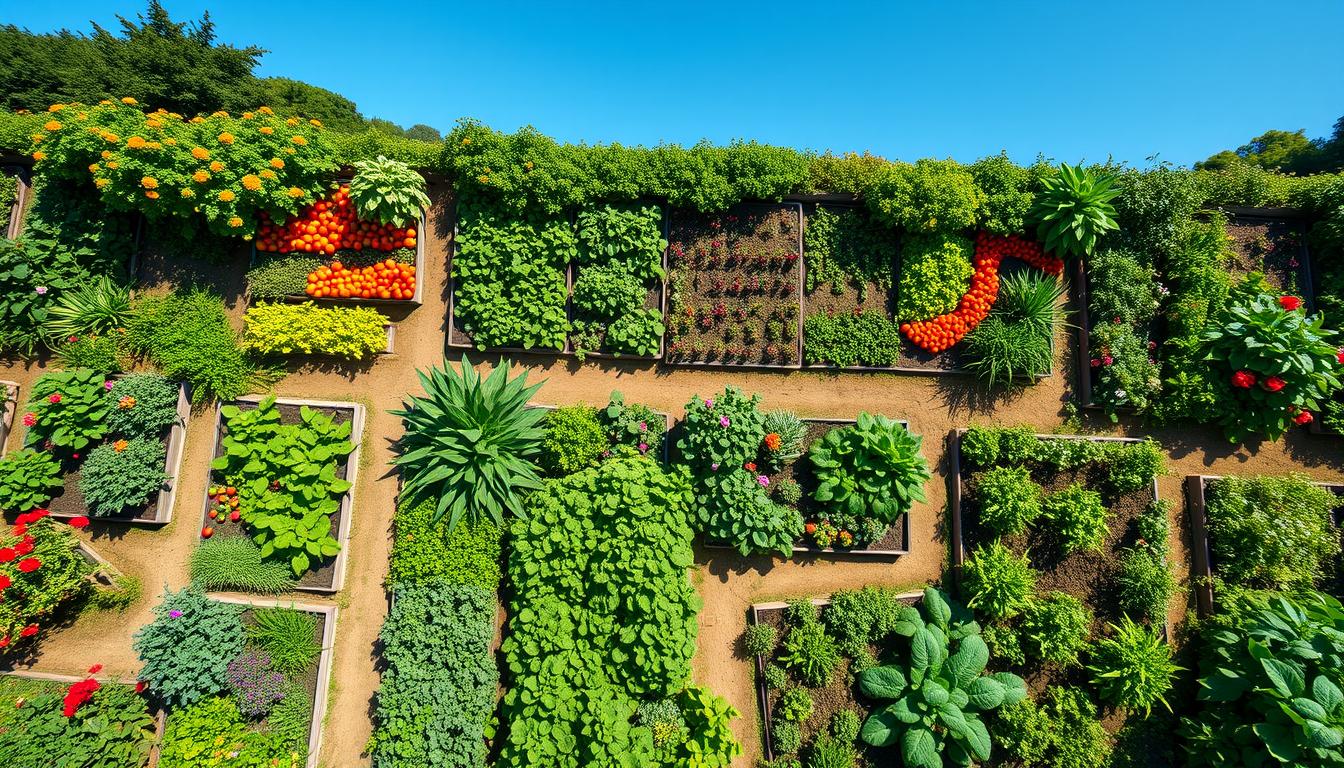I’m excited to share my favorite strategies for creating a thriving vegetable garden. I focus on the best designs to maximize your harvest. With the right layout, you can enjoy a bountiful yield and make the most of your space.
The layout is key in vegetable gardening. I’ve learned that a well-planned layout can make all the difference. In this guide, I’ll cover various aspects of vegetable gardening. This includes understanding garden layouts, choosing the right location, and planning your garden size and shape.
Whether you’re a beginner or an experienced gardener, this guide has valuable insights and tips. It will help you create a beautiful and productive vegetable garden. You’ll learn about effective layout ideas and the best designs.
Understanding Vegetable Garden Layouts
A well-planned vegetable garden layout is key to a successful harvest. I think about sunlight, soil quality, and drainage when designing my garden. This helps me create a layout that suits my needs and boosts my yield. Whether I have a big yard or a small garden, creative layouts can make a difference.
Planning a small vegetable garden needs careful thought. I consider the space I have and the plants I want to grow. By choosing the right plants and arranging them wisely, I can have a thriving garden, even in a small area.
What is a Vegetable Garden Layout?
A vegetable garden layout is a plan for my plants, paths, and garden features. It considers each plant’s needs, like sunlight and water, for a harmonious and productive space.
Why Layout Matters for Vegetable Gardening
A good layout can greatly improve my garden’s success. It helps me:
- Maximize space and increase yields
- Improve air circulation and reduce disease
- Make the most of sunlight and watering
Basic Principles of Garden Design
When designing my garden, I focus on balance, proportion, and harmony. I also think about the garden’s flow, including paths and plant arrangement.
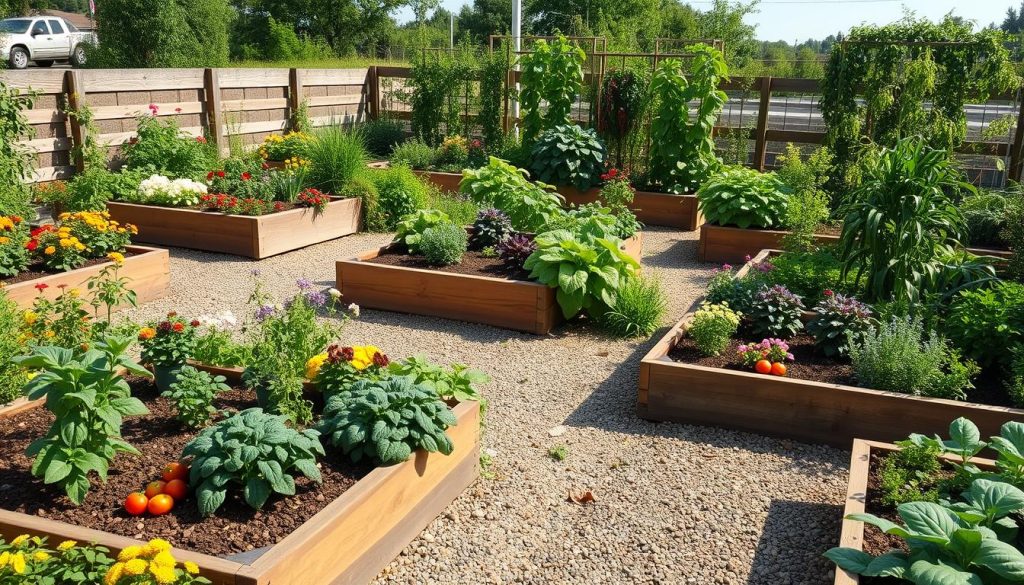
Choosing the Right Location for My Garden
Creating a thriving backyard vegetable garden starts with the right location. I look at sunlight, shade, soil quality, and drainage. This ensures my garden gets the best conditions for growth. By picking the perfect spot, I can make a productive and thriving garden.
Sunlight and Shade Considerations
Most vegetables need at least 6 hours of direct sunlight daily. I check my yard’s sunlight and pick a spot with the right amount. Some plants, like lettuce and herbs, can handle shade. But others, like tomatoes and peppers, need full sun.
I use shade cloth or other methods to filter sunlight. This prevents scorching and helps my plants grow well.
Soil Quality and Drainage
Soil quality and drainage are key when choosing a garden location. I test my soil to see its pH level and nutrient content. If needed, I add amendments to improve it.
I also make sure the location drains well. This prevents waterlogged soil, which can cause root rot and other issues. By thinking about these factors, I can create a thriving garden.
When picking a garden location, consider these factors:
- Amount of sunlight and shade
- Soil quality and pH level
- Drainage and waterlogging
- Wind protection and accessibility
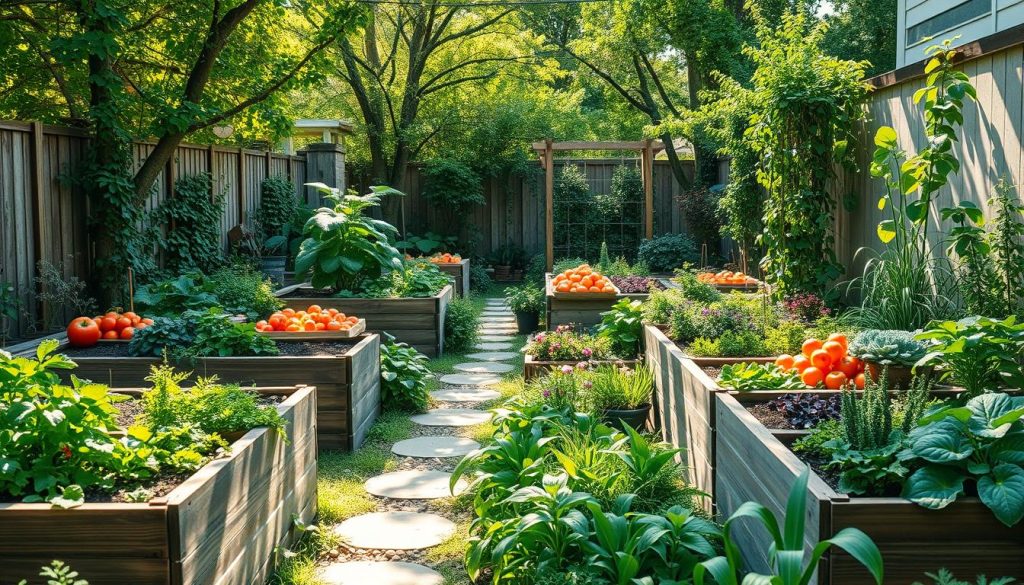
Popular Vegetable Garden Layout Ideas
Creating a thriving vegetable garden starts with the layout. A good layout maximizes space, improves soil, and boosts crop yields. Let’s look at some popular ideas to make your garden unique and productive.
Row Gardens: Straightforward and Effective
Row gardens are a timeless choice. They’re simple to set up and maintain. They also make watering and harvesting easier. Just divide your garden into long beds and plant in rows.
Raised Bed Gardens: Elevate Your Growing Space
Raised beds are ideal for small spaces or poor soil. They create a controlled environment with good drainage. Use wood, stone, or other materials to build your beds, then fill them with a mix of soil and compost.
Container Gardens: Flexibility and Mobility
Container gardens offer flexibility and mobility. They let you move plants as needed. Use pots or planters of all sizes, filled with soil and compost.
These ideas can help you design an organic garden that meets your needs. Choose a layout that ensures good soil, efficient watering, and easy harvesting. Feel free to experiment to find the best arrangement for you.
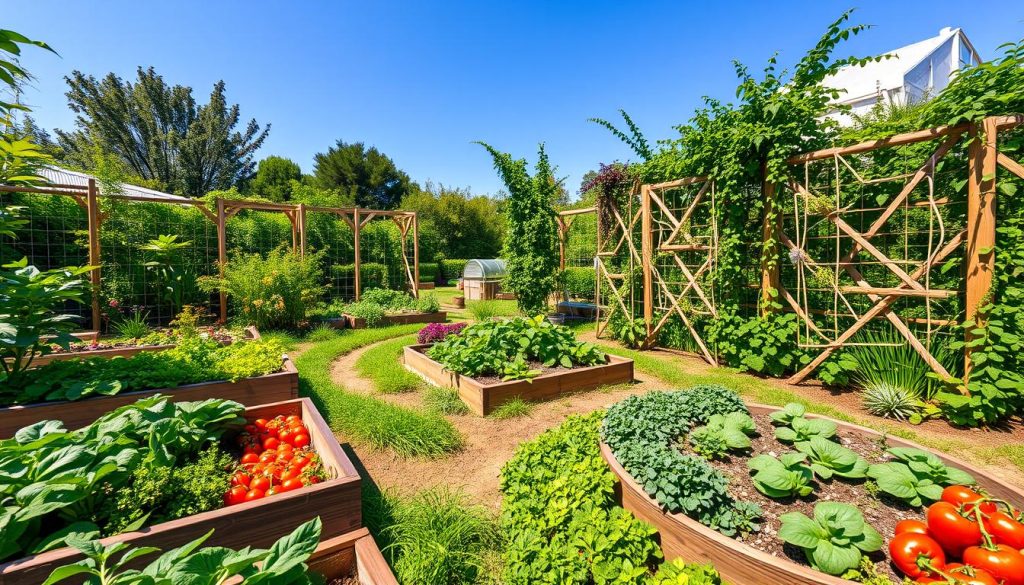
Planning My Garden Size and Shape
Creating a thriving vegetable garden starts with planning its size and shape. Small vegetable garden planning helps you use your space wisely. The best designs consider each plant’s needs and your desired look.
To figure out the right size and shape for your garden, think about these factors:
- Available space: How much room do you have for your garden?
- Desired yield: How much produce do you want to grow?
- Plant selection: What plants do you want to grow, and how much space do they need?
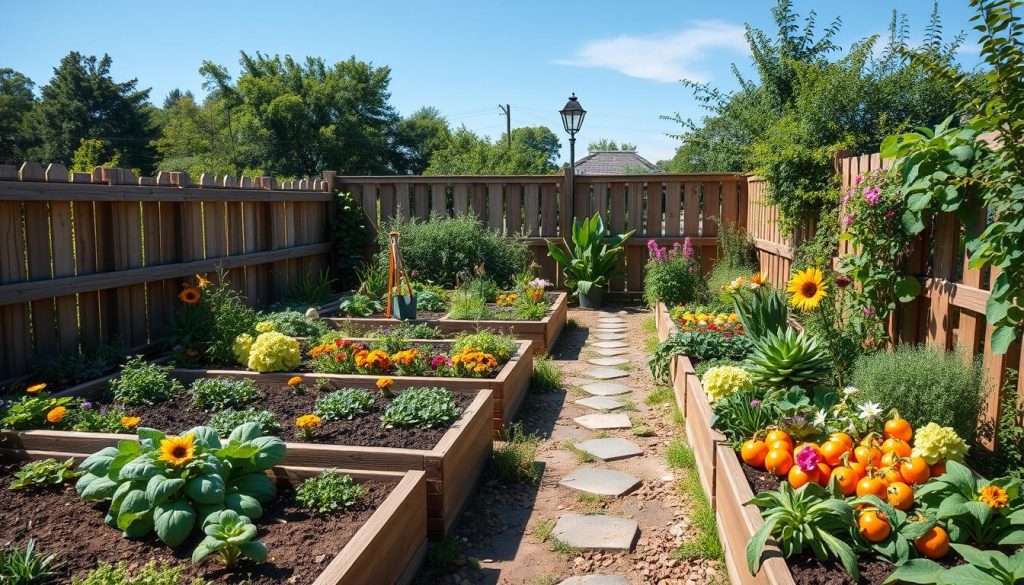
Small vs. Large Garden Designs
Small gardens are perfect for tight spaces, while large ones offer more room for creativity. The best designs balance looks and function.
Creative Shapes: Squares, Circles, and More
Creative shapes can make your garden stand out. They also help with arranging plants and making your garden easy to navigate. Try using squares, circles, or other shapes for a unique and practical garden design.
Companion Planting Techniques
When planning my vegetable garden, I think about companion planting. This method involves growing different vegetables together to boost their growth and yield. By using companion planting, my garden becomes more diverse and strong.
Companion planting helps keep pests and diseases away. For instance, marigolds near tomatoes can ward off nematodes. Basil with lettuce can keep aphids at bay. I arrange these plants creatively to get the most out of their benefits.
Benefits of Companion Planting
Companion planting offers many advantages. It can make plants grow faster, produce more, and fight off pests and diseases. By picking the right plants, my garden becomes a thriving ecosystem.
Examples of Great Companion Pairs
Here are some excellent pairs for companion planting:
- Tomatoes and basil: Basil keeps pests away from tomatoes and adds taste to tomato dishes.
- Marigolds and carrots: Marigolds fight nematodes, which harm carrots.
- Radishes and cucumbers: Radishes keep cucumber beetles away, which spread diseases.
By adding companion planting to my garden plans, I make it more varied and strong. With some planning and creativity, I can enhance my garden’s health and yield. This way, I enjoy a rich harvest of fresh, tasty vegetables.
| Vegetable | Companion Plant | Benefit |
|---|---|---|
| Tomatoes | Basil | Repels pests, adds flavor |
| Carrots | Marigolds | Repels nematodes |
| Cucumbers | Radishes | Repels cucumber beetles |
Rotation and Succession Planting
As I care for my backyard vegetable garden, I’ve learned about rotation and succession planting. These methods keep my garden healthy and productive. They also help me get a lot of food from my garden.
When I plan my garden, I think about rotating crops. This stops the soil from losing nutrients. It’s a smart way to keep my garden going strong.
Why I Rotate Crops Each Year
Rotating crops is key to keeping the soil healthy. It stops pests and diseases from taking over. Here’s why I do it every year:
- Avoids soil depletion: Different crops need different nutrients. Rotating them keeps the soil balanced.
- Reduces pest and disease buildup: Changing crops breaks the life cycle of pests and diseases. This lowers the risk of infestation.
- Improves soil structure: Some crops, like legumes, have deep roots. They help loosen the soil. Others, like corn, have wide roots. They help hold the soil together.
How Succession Planting Maximizes Harvest
Succession planting helps me get more food from my garden. I plant small batches of seeds every few weeks. This way, I always have fresh produce.
| Crop | Planting Interval | Harvest Time |
|---|---|---|
| Lettuce | Every 2 weeks | 40-50 days |
| Radishes | Every 1-2 weeks | 20-30 days |
| Green beans | Every 3-4 weeks | 50-60 days |
By using rotation and succession planting, my garden thrives. It gives me a lot of food all season long.
Incorporating Pathways in My Garden
When designing my vegetable garden, I focus on making it easy to get around. A good garden layout should have paths for easy walking and upkeep. This makes my garden look better and work better too.
The Importance of Accessibility
A good pathway in my garden is key. It lets me walk around easily, care for my plants, and pick my crops without trouble. It also stops the soil from getting too hard, which is bad for my plants.
Various Pathway Materials and Options
There are many materials I can use for pathways. Some popular ones are:
- Gravel or decomposed granite, which drain well and are simple to put down
- Brick or stone pavers, for a fancy and pretty look
- Wood chips or bark, which are natural and keep weeds down
Adding pathways to my garden makes it both unique and useful. It meets my needs and makes gardening more enjoyable.
| Pathway Material | Advantages | Disadvantages |
|---|---|---|
| Gravel | Good drainage, easy to install | Can be messy, may require frequent replenishment |
| Brick or Stone Pavers | Decorative, durable | Can be expensive, may require professional installation |
| Wood Chips or Bark | Organic, suppresses weeds | May attract pests, can be slippery when wet |
Vertical Gardening Solutions
Exploring vegetable gardening, I found vertical gardening’s benefits. It lets me use space better in my small garden. This is great for planning small vegetable gardens and creating the best designs.
Maximizing Space with Vertical Structures
Vertical gardening uses walls, trellises, or supports to grow plants up. It saves space and adds beauty to my garden. Popular structures include:
- Wall-mounted planters
- Trellises for climbing plants
- Vertical gardening systems with built-in watering
Best Plants for Vertical Gardening
Choosing plants for vertical gardening, I pick compact, small fruiting, or vining ones. My top picks are:
- Cherry tomatoes
- Cucumbers
- Peas
Seasonal Considerations for My Layout
When planning my vegetable garden, I think about the seasons. I want my garden to thrive all year. I choose layouts that meet each season’s needs.
In spring and summer, I plant crops that love the warmth. My favorites include:
- Tomatoes
- Cucumbers
- Carrots
- Radishes
For fall and winter, I pick crops that handle cold. With some planning, my garden stays productive, no matter the season.
By planning for each season, I make my garden a joy. It gives me fresh produce all year.
| Season | Crops to Plant | Garden Maintenance |
|---|---|---|
| Spring | Tomatoes, cucumbers, carrots | Soil preparation, fertilization |
| Summer | Radishes, beans, corn | Irrigation, pest control |
| Fall | Broccoli, kale, spinach | Soil preparation, mulching |
| Winter | Brussels sprouts, cabbage, onions | Cover cropping, fertilization |
Sustainability in Vegetable Gardening
As I tend to my vegetable garden, I’ve learned about the need for sustainability. It’s about using methods that help my garden and the planet. Organic gardening is key for a healthy, thriving garden.
Benefits of Organic Methods
Organic gardening has many advantages. It improves soil health, saves water, and cuts down pollution. By using these methods, I create a balanced garden ecosystem. This supports my vegetables’ growth.
Here are some tips for organic gardening:
- Use natural pest control, like beneficial insects or neem oil.
- Make a compost pile from food scraps and yard waste.
- Rotate crops to keep soil fertile and pest-free.
Composting and Soil Health Strategies
Composting is vital for sustainable gardening. It turns waste into nutrient-rich soil. This keeps my garden healthy and supports my vegetable’s growth.
Utilizing Garden Helpers
As I work on my backyard vegetable garden, I see how crucial it is to welcome garden helpers. These include pollinators and beneficial insects, essential for a healthy garden. I use a raised bed layout to improve soil quality and drainage, attracting these helpers.
Attracting Pollinators to My Garden
To draw in bees and butterflies, I plant various flowers for nectar and pollen. Some of these are:
- Sunflowers
- Zinnias
- Marigolds
These flowers brighten my garden and feed pollinators.
Beneficial Insects and Their Roles
Beneficial insects like ladybugs and lacewings fight pests in my garden. I offer them food and shelter. For instance, I grow herbs like dill and parsley, which attract them and flavor my dishes.
| Beneficial Insect | Role in the Garden |
|---|---|
| Ladybugs | Control aphids and other pests |
| Lacewings | Control whiteflies and other pests |
By welcoming these garden helpers, my garden becomes a balanced, thriving space. It needs less pesticides and fertilizers.
Tips for Maintaining My Vegetable Garden Layout
Maintaining a thriving
small vegetable garden
is an ongoing journey. It can be rewarding with the right approach. I’ve learned that regular maintenance is key to keeping it in top shape.
By dedicating time to pruning, watering, and fertilizing, my plants stay healthy. They continue to produce bountiful harvests.
Regular Maintenance Routines
Setting aside a few hours each week to tend to my garden is essential. This includes removing weeds, deadheading flowers, and monitoring for pests or diseases. I also water my plants deeply and apply organic fertilizers to replenish soil nutrients.
By being consistent with these maintenance routines, my
best vegetable garden designs
stay thriving throughout the growing season.
Adapting My Layout Over Time
As my garden matures and my needs change, I’ve learned to be flexible. I may need to rearrange plant placements, add new structures, or even expand the garden size. By staying attuned to my plants’ needs and the evolving dynamics of my outdoor space, I can make adjustments.
With a little creativity and adaptability, I can keep my vegetable garden layout fresh and productive year after year.

